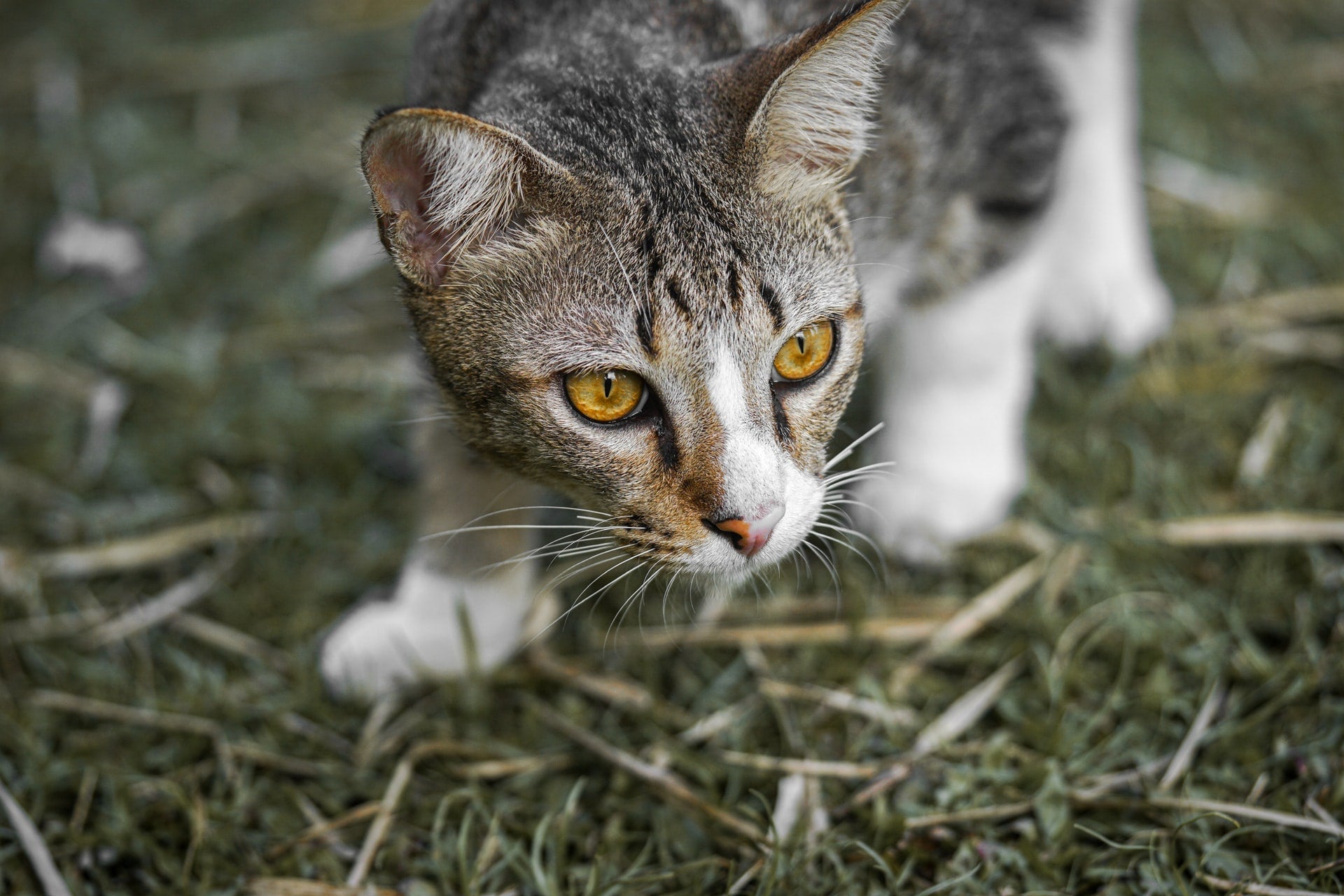Kittens are born with a desire to chase, which is reflected in how they chase and pounce on their siblings, toys, or that tiny moving laser dot. This desire to stalk and chase stays throughout adulthood; you may find that even the oldest, laziest cat still wants to play with the piece of string you dangle in front of her.
We may think of hunting as something only big cats like lions and tigers do, but the fact is that all felines have an instinctive prey drive. Understanding your cat’s prey drive is crucial to keeping your cat happy and healthy.
What is Prey Drive?
Cats, like dogs, have a natural prey drive, or desire to hunt and chase. Because cats are obligate carnivores, they need to eat meat in order to survive. Cats who aren’t being fed by humans use their prey drive to hunt and find food, generally consisting of small mammals and birds.
Prey drive refers to your cat’s desire to hunt and chase,but not necessarily to kill and eat. (Although, if your cat’s food supply suddenly disappeared, she would likely tap into her prey drive and learn how to hunt for her own food.)
If your cat brings home dead prey such as a bird or mouse and drops it at your feet, she’s probably trying to show you how to hunt, just like she would show her kittens. She may also be trying to reassure you that even though you’re not a great hunter, she’s there to provide for you. Or, she’s just proud of her achievement and wants to show it off.
Even if your kitty is well-fed, her prey drive isn’t going anywhere—it’s an instinct. She may not be hunting actual prey, but you may still find her catching bugs and dust bunnies around the house, or pouncing on her toy mouse.
Do Cats Hunt When They’re Hungry?
As we know, the motivation to eat is driven by hunger. However, if wild and feral cats waited to hunt until they were hungry, they would risk not having enough energy to catch their prey—and, ultimately, starving.
Instead, they take a more opportunistic approach. If they see prey within their reach, they’ll try to catch it regardless of hunger. As a result, your well-fed house cat still has the instinct to hunt, even if she gets her fair share of high-quality cat food on the daily.
A domesticated house cat doesn’t hunt nearly as much as her feral counterparts, though. In fact, she only hunts for about three hours per day, compared to a feral cat’s 12 hours.

Why Do Cats Play With Their Prey?
If your kitty does you the favor of catching a cockroach but won’t kill it or stop playing with it, there may be a reason. There are a few theories about why cats play with (or rather, torture) their prey before or instead of killing and eating it.
For one, domesticated house cats may lack confidence in their hunting skills. After all, chasing after a string on a rod isn’t quite the same as pouncing on a real mouse. This lack of confidence can make your kitty feel a bit scared of her prey, as she’s feeling a bit conflicted about wanting to kill it but also protect herself.
Hunting is also a rare event for house cats, so it’s possible that she simply wants to prolong the activity as long as possible.
Can Cats Get Along With Prey Animals?
If they’re socialized early enough, it’s possible that your cat may learn to be friendly with your smaller pets. That being said, the two should never be left unsupervised or you may end up with a Tom & Jerry or Tweety Bird & Sylvester type of situation.
You never know what’s going to cause your cat to pounce on her potential prey—even if she’s just trying to play—so it’s probably best to keep your cat separate from your smaller pets for the most part.
If you have an outdoor cat, we recommend putting a bell on her collar to warn birds of her arrival. That way, they have time to fly away before they potentially become your cat’s lunch.
Satisfying Your Cat’s Prey Drive at Home
Whether there’s prey to hunt or not, your cat still has a prey drive. There’s no use trying to get rid of it, because it’s here to stay. In fact, if you don’t provide appropriate outlets, your cat may decide to turn furniture, decorations, and fingers and toes into her next targets.
One great outlet is play. Play with your cat using point lasers or toys that move or are attached to wires and strings to stimulate her prey drive. Something as simple as a dangling piece of string or paper may even be sufficient, as long as it’s giving her something to chase and grab. Plus, if your cat is feeling well-exercised and content, she’s less likely to wreak havoc around your house while you sleep.
If you have multiple cats you may see them wrestling, chasing each other, and play fighting from time to time. Unless you see signs that the playing has turned into real fighting (flattened ears, puffed up fur, hissing, or scratching), then there’s generally no need to worry or intervene.
Providing satisfying meals with high meat content can also help to appease your cat’s inner prey drive, especially if she’s an outdoor kitty who tends to bring home dead prey as trophies.
In addition to providing plenty of play time and healthy meals, you can boost your cat’s health with PetHonesty’s cat supplements: Lysine Immune Health+ Powder and Digestive Probiotics+ Powder.
Sources:
https://www.comfortzone.com/behavior-blog/multi-cat-tension/are-my-cats-playing-or-fighting
https://www.perfectpaws.com/help3.html#.YKwPFZNKj_Q
https://www.pets4homes.co.uk/pet-advice/understanding-the-cats-prey-drive.html













